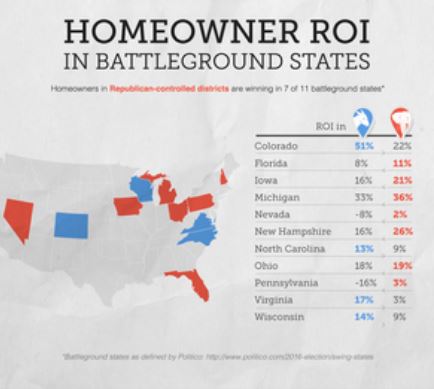 While the debate continues as to how the new president will affect housing in the United States after January, the data shows that the return on investment (ROI) for single-family houses located in Democrat-controlled districts has been double that of houses in Republican-controlled districts since President Obama took office.
While the debate continues as to how the new president will affect housing in the United States after January, the data shows that the return on investment (ROI) for single-family houses located in Democrat-controlled districts has been double that of houses in Republican-controlled districts since President Obama took office.
According to a study released Wednesday by ATTOM Data Solutions [1] which analyzed 2.4 million single-family homes purchased eight years ago, houses in located in districts controlled by Democrats had gained an average in value of $59,467 since they were purchased, which is a 21 percent ROI.
By comparison, houses purchased at the dawn of the Obama Administration located in Republican-controlled districts have gained an average of $22,086 in value, which represents a 10 percent ROI.
“I think the districts that tend to be Democratic and the states that have a lot of Democratic-controlled districts tend to be more urban,” said Daren Blomquist, SVP, ATTOM Data Solutions. “And also coastal markets that have seen a stronger bounceback in home prices during the recovery of the last few years. California has the most homes in Democratic-controlled districts than any state, and Los Angeles County has the most homes of any county nationwide in Democratic-controlled districts, and that is the type of county that we're seeing has recovered very, very strongly during this recovery.”
 There is good news for those homeowners in Republican-controlled districts, however. Those homeowners are paying lower property taxes (an average of $2,514, or a 1.02 percent effective tax rate) than those in Democrat-controlled districts (an average of $3,659, a 1.07 percent effective tax rate). Also, contrary to the national trend, the ROI has been higher for homes in Republican-controlled districts in seven out of the 11 battleground states for the upcoming presidential election.
There is good news for those homeowners in Republican-controlled districts, however. Those homeowners are paying lower property taxes (an average of $2,514, or a 1.02 percent effective tax rate) than those in Democrat-controlled districts (an average of $3,659, a 1.07 percent effective tax rate). Also, contrary to the national trend, the ROI has been higher for homes in Republican-controlled districts in seven out of the 11 battleground states for the upcoming presidential election.
“In many of those states, but not all of them, what we see going on is they were hit hard by the housing downturn, and we see the Democrat and Republican districts more closely matched in those states—but with the Republican-controlled districts winning out by just a few percentage points,” Blomquist said. “In Florida, for example, the Democratic districts saw an 8 percent return, whereas in Republican districts it was an 11 percent return. In Michigan, it was 33 percent versus 36 percent. In Ohio, it was 18 percent versus 19 percent. We saw a lot of close calls like that, but what that tells me is that those were all states that were hit hard during the recession and everybody has struggled to come back from that hole that was dug during the recession. It's a little bit more of a level playing field in those districts with the Republican districts winning out by just a few percentage points.”